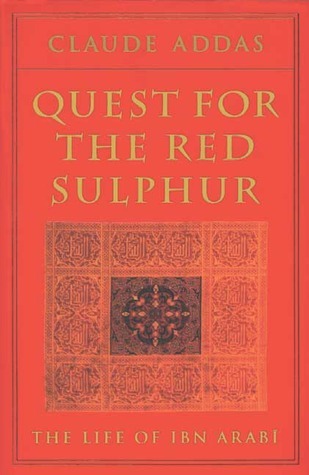 Quest for the Red Sulphur: The Life of Ibn ʻArabī written by Claude Addas and translated by Peter Kingsley is a biography of one of the greatest Islamic personalities.
Quest for the Red Sulphur: The Life of Ibn ʻArabī written by Claude Addas and translated by Peter Kingsley is a biography of one of the greatest Islamic personalities.
Ibn ʻArabī is perhaps the most iconic saint in the Islamic tradition. He is referred to as the Shaykh al-Akbar (The Greatest Shaykh) and many other lofty titles by his contemporaries as well as the scholars and the saints to follow after. This is sufficient enough for any Muslim to at least attain some cursory knowledge about him and how he has influenced the ummah. I would have to credit the creators of the Ertugrul TV series for reviving some popularity on Ibn ʻArabī among the crowd because Ibn ʻArabī’s work (approximately 800 writings from him) and his large influence make him an exemplar to study within Islamic civilization. He travelled the worldly plane his entire life, and one can earnestly say he traveled the spiritual plane his entire life as well. He spent 30 years in the West in Andalus, Algeria, and so on, then spent 5 years in the holy sanctuaries of Mecca and Medina, and finally spent the last 30 years of his life in the East in the lands of Shaam particularly Damascus. He was a wanderer, a salik, and sought God in seclusion in the idyll of nature. At the very same time, he was highly influential among the caliphs, princes, and high-ranking notables of his time. He had close ties to many caliphs and often directly influenced their opinions regarding political and governmental changes. Ibn ʻArabī was from a noble lineage himself and considered from among the high-class of his people in Andalusia. He frequented the scholars at an early age and was attributed to having incredible intellect and wisdom at a very early age in his life.
The term awliya which is roughly translated as friend of God can also be compared to saints as used in the other Abrahamic faith traditions. These are the foremost of believers in God that surpass everyone else by a large margin. It’s said that one in every forty believers is a wali (friend) of God, and it’s these people that keep the world in check from the tyrants, oppressors, self-worshipers, magicians, and so on.
Ibn ʻArabī took murids (disciples), founded his own tariqa (spiritual fraternity), and more importantly transmitted all his knowledge to some of his most ardent disciples. Until this day we have records of his knowledge transmitted to us in each generation for the last 800 years. Like with most other Sufi masters who take on disciples and found a tariqa this is commonplace for the people of tasawwuf.
I want to analyze the title The Quest for the Red Sulphur. In the secularist world we live in are fringe minorities that proffer ideologies and theosophies that are largely taken from mystical interpretations of orthodox monotheistic doctrine in the attempt to conjure half-truths through an esoteric spiritualism. To some degree traditional Islamic Sufism has been a victim to this project. In other words, Western new-age religions and occultism attempt to purport esoterism through sacrilegious means by attempting to secularize traditional Islamic Sufism and other monotheistic mystical traditions. Although the notion of the Red Sulphur stems from an Islamic scientific and mystical origin, in today’s world what the Red Sulphur may purport to be in new-age theosophies and occultism is categorically false and has absolutely no bearing to the true reality of Ibn ʻArabī, his authentic teachings, and to even the historicity of alchemy as originally developed by Muslim scientists and mystics. To read Ibn ʻArabī from this outlook is a serious detraction from traditional Islamic Sufism, traditional Sufi’s, and the notable saints and sages among them. All and most especially of which Ibn ʻArabī ascribed too. Ibn ʻArabī who coasts along the apex of the Islamic saintly spectrum for the record was a traditional Sunni Muslim, a traditional Sufi master, a serious practitioner of the Shariah (Divine Law), almost certainly a hafiz (memorizer) of Qu’ran, embodiment of the Sunnah (way of the Prophet Muhammad), and awliya of the utmost caliber. Ibn ʻArabī can clearly be described from among the closest of proximity of believers to mimic the light embodied by the Prophet Muhammad, God bless him and grant him peace. Not with this in mind can one begin to successfully approach Ibn ʻArabī.
Before continuing let us quickly remark on the status of the Prophet Muhammad, God bless him and grant him peace. It’s known that out of every 40 people one is a wali, whether that wali knows they are a wali or not. It’s known that Ibn ʻArabī is among the greatest if the not greatest saint in Islam, he self-describes as the seal of the Muhammadan saints in his works. It’s known that one Prophet is greater than all of the saints put together. It’s known that of all the approximately 124,000 Prophets since the beginning of Adam, the five greatest Prophets were Noah, Abraham, Moses, Jesus, and Muhammad, upon all of them be peace. Finally, it’s known that the Prophet Muhammad, God bless him and grant him peace, is the Seal of the Prophets and greatest of the five. In conclusion, even if the entire human population were saints at the stature of Ibn ʻArabī there is no comparison of them put together to the Prophet Muhammad, God bless him and grant him peace.